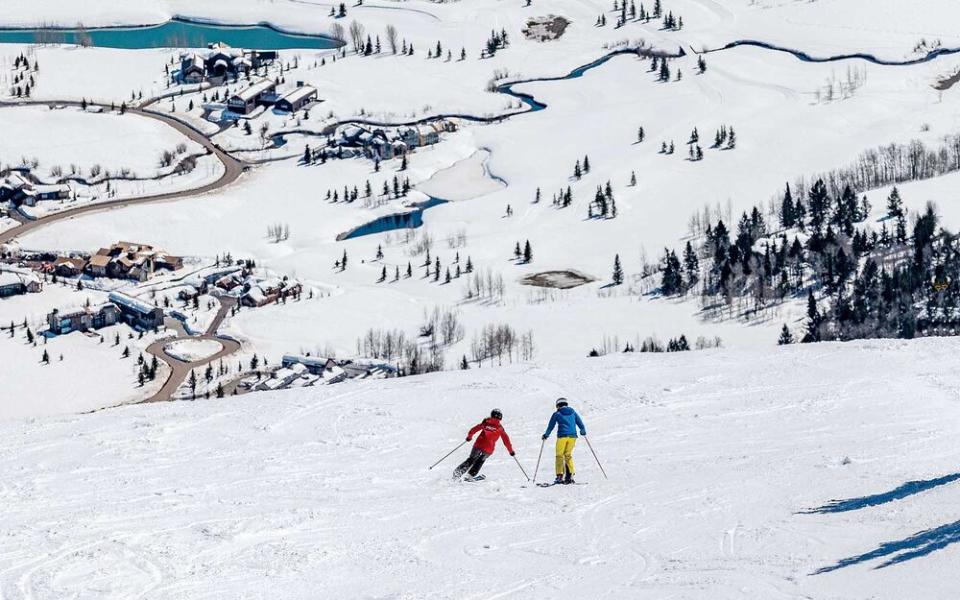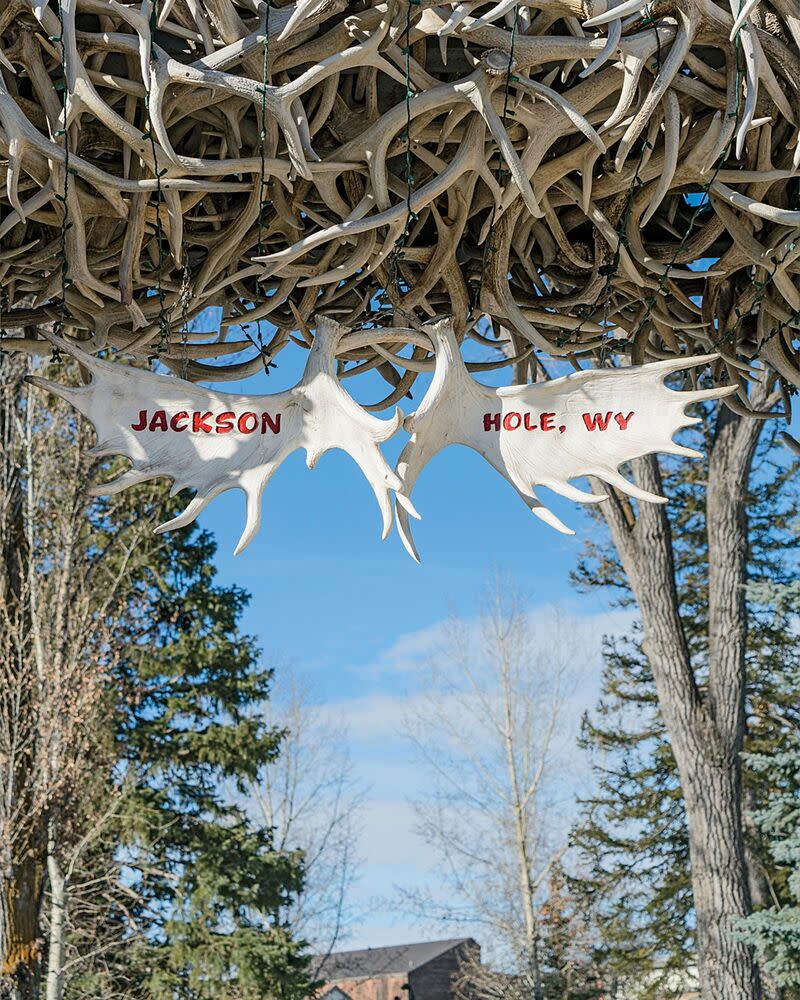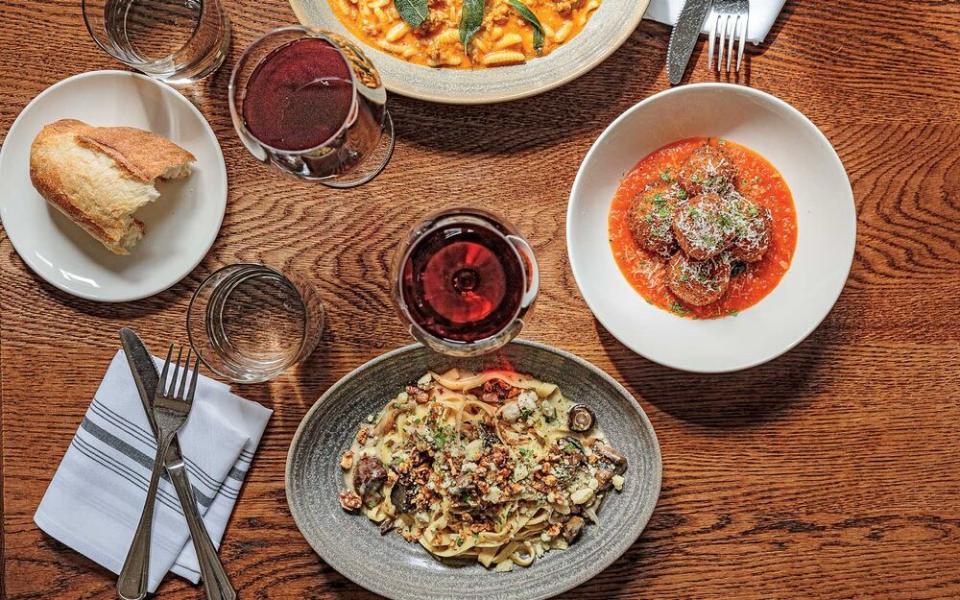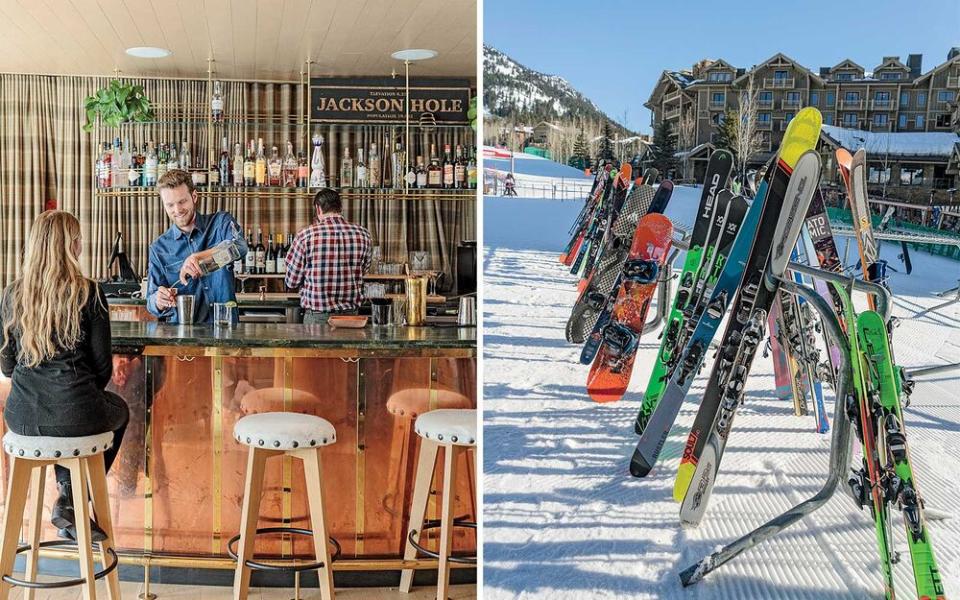Jackson Hole: Stylish Western Ski Town Families and Non-skiers Will Love
You’ll definitely want to wait until at least 10 a.m.," said the tattooed pro-shop clerk, with the kind of yeah-braah stoner's talk-laugh that makes you feel your middle age. This followed the lengthy note about "Conditions…" that arrived in a 6:45 a.m. text from our guide, Paul Boillot.
It was March, and the tail end of 2019's record-setting, 505-inch season of snowfall in Jackson Hole, the wide valley that encompasses both the town of Jackson and the namesake Jackson Hole Mountain Resort in Teton Village. Until our arrival, the mountain had seen several consecutive bluebird days. My family and I were hell-bent on leveraging our East Coast–calibrated body clocks for full days of skiing, despite warnings of poor visibility and icy terrain. By 7:30 a.m., we were all-but-helmet ready. How bad could it be? I thought.
Paul compromised with us on a 9:30 start. We met at the Sweetwater Gondola, just steps from our hotel, Caldera House, in the heart of Teton Village. When this boutique property opened in 2018, it replaced a beloved honky-tonk — a loss that half the town was still smarting over. (Most evenings the other half seemed to spill out of the stylish yet cozy joint on Caldera's ground floor.)
"We skied Deer Valley most recently," I heard my 15-year-old son, Henry, say to Paul, who smiled and nodded politely. I'd later learn from the barman at our hotel that such an admission was, for Jackson Hole residents, tantamount to getting pushed into a wave and calling it surfing. We stuck to the lower part of the mountain that morning, but fog as thick as meringue all but erased any trace of the skier ahead in our five-person slalom train. We all agreed that these slopes felt different — or, as my younger son, 13-year-old Will, said, "I feel like I have banana peels on my skis."

"The snow still needs to soften," said Paul, sensing a dip in our confidence. "Jackson is not like any other mountain — it's not for those who want their egos coddled." Seeing our need for a pick-me-up, he led us down a minor chute just off the Marmot double chairlift. Without hesitation, the boys shot straight down, caught some air, and landed easily on the wide gentle run below. I, on the other hand, chickened out at the sight of the narrow drop-in — just a two-foot plunge, but flanked by rocks. "What makes it so special is that it's a different mountain every day," Paul said later. "You have to read the terrain, be on your toes, never get complacent."
And therein lies the paradox of the place: underpinning the thrill-seeking badassery of those who live and play in Jackson Hole is a near-religious reverence for the elements. Long considered the ultimate skier's mountain, it delivers a one-two punch of tough love and, just when you need it most, adrenaline-rush euphoria.
Related: 10 U.S. Ski Resorts Every Snowbird Needs to Visit in Their Lifetime
Which, once you get a taste of, I was warned, you can never quite shake. As I heard for the third time that morning about the infamous, bucket-list, double-black-diamond Corbet's Couloir — a 10- to 20-foot drop-in — the only thing I couldn't shake was my bruised ego.
"This place could have gone the way of Aspen or Vail," said Erik Warner, a cofounder and principal of Eagle Point Hotel Partners, which owns the haute-hipster Anvil Hotel in downtown Jackson. Except that with the mountain's 4,139-foot vertical drop culminating with the summit of Rendezvous Mountain at 10,450 feet, there is, as Warner said, "a high barrier to entry in this town." And while Jackson Hole Mountain Resort prides itself on its 133 trails comprising some 2,500 acres of inbound terrain, half of which are expert slopes, it has also been investing heavily in making itself more accessible to beginner and intermediate skiers. It's added nearly a dozen new intermediate trails, and with the unveiling this past season of the 12,000-square-foot Solitude Station — the new and upgraded ski-school center — the resort is poised to go toe-to-toe with more family-friendly winter destinations like Snowmass, in Colorado, and Park City and Deer Valley, Utah.
Related: The 10 Best Family-friendly Ski Resorts Cater to Kids — and Kids at Heart (Video)
It's an improbable path for a place where the very landscape seems to spurn outsiders. Ringed by the Teton and Gros Ventre Mountain ranges and abutting Grand Teton and Yellowstone National Parks, the still-pristine Jackson Hole valley — once hallowed big-game-hunting ground for Crow, Shoshone, Blackfoot, Gros Ventre, and Nimiipuu tribes — has long been defined by its geographic isolation.
The Lewis and Clark expedition opened up the area and ushered in a brisk fur-trapping trade that declined in the late 19th century, when beaver hats fell out of fashion. It was only when the Hayden Geological Surveys of the 1870s provided the first photo evidence of the Teton Mountains and neighboring Yellowstone that the government committed to protecting the area, turning Yellowstone into America's first national park. Cattle ranching replaced trapping and paved the way for the more permanent settlement of the early 20th century, remnants of which you see today in Jackson's town square and the Million Dollar Cowboy Bar, a country-and-western institution since 1937. And, beyond being mascot fodder for the Wyoming license plate and souvenir key chains, the cowboys themselves are still around. You can see them for yourself, spinning their dates at the Stagecoach Bar in nearby Wilson on Sunday nights. This weekly ritual is known as "church," and the house band, led by legendary extreme skier turned banjo and autoharp player Bill Briggs, still plays to a packed room — as it has for nearly 50 years.
The truth is, we almost didn't make it to "church," despite the urgings of my most trusted sources. We were all exhausted, and more than a little sad to see my husband leave a day early to make an important meeting. No matter how much we travel, there is something about one person leaving on an earlier flight after days of concentrated togetherness that's disproportionately difficult. And there is something special about a family ski trip — the hang time on the chairlift with a newly laconic teen who reveals more in five minutes under a helmet than he has in months, the good-clean-fun physicality of it, the way in which, huddled together in a booth, a bowl of chili has never tasted better.
But I made us venture out, despite the fact that our instincts were to stay in the hotel and order room service. Since the boys are underage, we had to stay away from the bar. I ordered them ginger ales and myself a beer at a standing cocktail table. After a few awkward moments of watching couples dance, we almost couldn't help joining in, clapping, toe-tapping, marveling at the elegance of partners who'd been in lockstep for a lifetime. Later, as we sat in the dining area in the back and scarfed our cheeseburgers, Henry said, "I can't believe there are still actual cowboys."

Jackson is still the independent-spirit capital of the West. People here were specializing in the live-work-play multi-hyphenate existence long before hyperconnectivity was a thing. We learned on a gondola ride that Paul — a ringer for Colin Firth whose Continental elocution reveals an Upper-East-Side-by-way-of-French-boarding-school upbringing — works in Jackson as a residential architect while moonlighting as a ski instructor. His story is like so many I heard during my visit: a college-educated, white-collar-career-bound professional from someplace else drops in a for a summer or winter season and stays for 25 years. "This place attracts a certain like-minded set of people who want to keep pushing themselves to become better skiers, athletes, or whatever they're into," he said.
In part, Jackson Hole owes its special somethingness to the collective talents and protective instincts of outsiders who come here and fall in love with its unspoiled beauty. In the 1920s, John D. Rockefeller quietly, albeit controversially, bought thousands of acres with the express purpose of donating them to the government to expand Grand Teton National Park. Today, conservationist families like the Waltons and Rockefellers, supported by low-key celebs such as Harrison Ford, Brad Pitt, and Sandra Bullock, carry on the tradition of buying up land for conservation.
But year-rounders, those professional polymaths who support this rarefied ecosystem by working on and off the mountain, make far bigger sacrifices than, say, part-time residents donating acreage. With 97 percent of Jackson Hole land under state or federal protection, the greatest challenge for those who live and work there is also the area's saving grace — land and job scarcity force a kind of natural selection. "I always say Jackson is much more like Manhattan than people think," Paul said. "It attracts the best of everything — and those who never rest on their laurels — because it's so hard to make it work."
Even as the region evolves, business owners like Erik Warner are careful to stay true to its original spirit. Warner, for one, sees himself more as caretaker than proprietor. He first fell for the area 23 years ago when he took a job as a desk clerk at what was then the Anvil Motel. Over the years, he maintained a friendship with the couple who owned it, so when it came up for sale in 2015, the decision was a no-brainer.
The result is the 49-room Anvil, designed in a log-cabin-meets-schoolhouse style with nods to the building's history as a blacksmith's shop. Glossy dark-green wainscoting and Woolrich blankets confer a level of sophistication upon the simple but stylish converted motel rooms; locally sourced mini-bar snacks and C.O. Bigelow bath products speak to a modern clientele that values great coffee, microbrewed beer, and a good mattress over white-gloved butler service. My boys, for their part, loved that we were a stone's throw from two thrift stores, where they found prizes like a vintage belt buckle.

Glorietta, the hotel's excellent Italian restaurant, serves creative but uncomplicated house-made pastas and exactly the kind of entrées you want to eat after a day of skiing, such as wood-fired whole trout and a perfectly rare bistecca alla Fiorentina. Warner's insistence on "paying homage" to the region's legacies extends to the hotel's programming, which connects guests to workshops with artists as well as to live music and tastings of local spirits.
Even the unapologetically high-end Caldera House represents a more thoughtful luxury hotel experience than you might find elsewhere. Sitting by the tram on some of the most prime Teton Village real estate, the eight-suite hotel took six years and more than $100 million to execute — sparing no expense with custom millwork, whimsical bathroom tiles, and take-me-away copper tubs. But with its small footprint and Scandi-Shaker aesthetic, Caldera House shares more DNA with Soho House and cult favorites like Ett Hem in Stockholm — not to mention the sheepskin-strewn, exposed-beamed luxury lodges of the Swiss or French Alps — than the usual five-star mountain resorts.
And while other ski resorts have welcomed slick luxury-brand outposts that inevitably erode local distinction, Jackson's restaurants and shops remain fiercely independent. Star restaurateur Gavin Fine, whose Jackson Hole empire started with Rendezvous Bistro and now includes the Kitchen, Enoteca, Bin 22, and Bovine & Swine, has all but bypassed an entire generation of squeeze-bottle-dotted, chef-y food in favor of a simpler farm-to-table — or, more accurately, greenhouse-to-table — approach.
Bin 22, the always-crowded wine store and tapas bar, serves salumi and seasonal vegetable-forward small plates (like the perfectly dressed Spanish salad of arugula, Manchego, and Marcona almonds and salmon rillettes I had one night) that are on par with big-city stalwarts.
Those who succeed here learn to navigate the perennial tension between evolution and tradition. As Ali Cohane, who owns the wildly popular Persephone Bakery and the Picnic café with her husband, Kevin, who trained as a pastry chef at Le Cordon Bleu in Paris, can attest, "It really means something to become a local, which is difficult to explain to an outsider." When Chicago-born Cohane wanted to paint her tiny storefront white, she had to go through an exhaustive permitting process to break with downtown Jackson's brown and green palette. The result is the kind of modest, Shingle Style cottage — white clapboard, slab Carrara marble, and reclaimed-wood shelves packed with linens, house-made jams and granola, Scandinavian- and Japanese-style ceramics, and, of course, French pastries — that wouldn't be out of place in London's Notting Hill or L.A.'s Abbott Kinney. And yet, with a growing number of artisanal, one-of-a-kind shops and cafés in the area, Persephone feels especially appropriate to Jackson and its discerning, if unflashy, clientele.

It's easy for the travel purist in search of cultural immersion to fetishize a place and imagine that one should only be eating, say, bison steaks in Wyoming. (At one point my 15-year-old, well-trained local food seeker that he is, asked me if it was okay for him to order tacos because "it doesn't seem authentic.") And even easier to forget that the frontier, and this place in particular, is the sum of those brave outsiders and their improbable pursuits — whether narrowly surviving the harsh winters and grizzly attacks 100 years ago, or today mastering Parisian-grade croissants and the perfect baguette crunch-to-chew ratio at 6,311 feet.
Or, in the case of Teton Thai, which has a cult following among the food cognoscenti, turning out totally authentic green curry and laab in a place with a four-month growing season. "It's a lot like being in Alaska and cooking out of a glorified food tent," said Sam Johnson, who owns the Teton Village institution with his Thai wife, chef Suchada Johnson. "Everything we make has to be shipped in. Nothing is easy." Now in their 18th year, the couple, with the help of Suchada's mother, Boonlua, serve up to 550 people a night from a tiny kitchen and make what is possibly the best version of tom kha gai I've ever eaten outside of Thailand.
The Johnsons, who live across the street with their two kids while Boonlua lives in a studio above the restaurant, have created a commute-less family compound that maximizes ski and snowboarding time. I was reminded of something John Koenig, who was then the food and beverage manager at Caldera House, had told me earlier: "There's a "whatever it takes to stay here" mentality to live in one of the world's greatest playgrounds that is the common thread and great equalizer."
By the end of our trip, everything Paul had told us about steep and icy conditions — flattening our uphill skis, our heads and upper bodies always facing downhill — made sense. "I feel like I know what I'm doing again," Henry said to me on the gondola. As we finished lunch, the morning fog layer seemed to lift in an instant, like a theater backdrop swapped out at intermission. Chubby clouds looked comically airbrushed with silver shadows and parted at time-lapse-video speed, revealing impossibly blue skies. With a view of the valley below too vast for a single pair of eyes, it was one of those make-sure-you-don't-blink moments you have on the very best trips. We made our way back up to the chute I'd avoided that first day without much discussion. "Remember, don't make any turns and don't stop," Henry said, parroting Paul's instruction as I rolled my ankles and pointed my skis downhill. "Let the mountain do the work." And, finally, I did.
How to Ski & See Jackson Hole
The Essentials
Jackson Hole encompasses both Teton Village, home to the ski resort, and the town of Jackson, just across the valley. The resort opens in late November. Rent gear from delivery service JH Mountain Direct or Jackson Hole Sports.
In Teton Village
The two- to four-bedroom suites at superchic Caldera House are ideal for groups. The delightful Teton Thai offers takeout if you don’t want to wait for a table. Don’t miss out on a pint — and an irrepressible toe-tap— at the Mangy Moose, the quintessential Western honky-tonk.
In & Around Jackson
Anvil Hotel, which just unveiled an upscale hostel, Cache House, is the place to stay. Its restaurant, Glorietta Trattoria, does fantastic Italian classics. You’d be hard-pressed to find a better croissant than at Persephone Bakery. Stock up on wine at Bin22, or linger there over salumi. If you can score a spot at the 24-seat King Sushi, you’re in for a treat — as much for the cocktails as for the inventive rolls. Million Dollar Cowboy Bar is an Instagram must. A short drive from downtown at the luxe Amangani, the Amangani Grill offers elegant fare with prime views of the Teton Range.
A version of this story first appeared in the December 2019 issue under the headline "Peak Wyoming."

